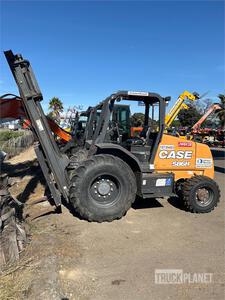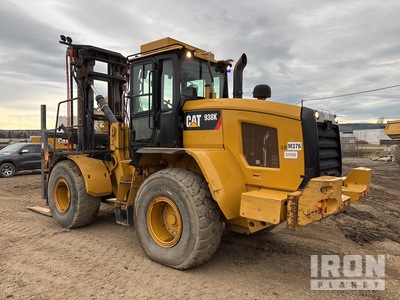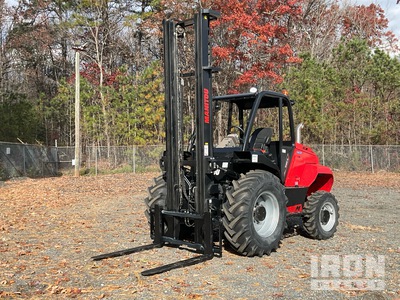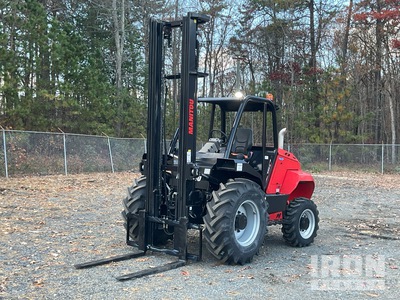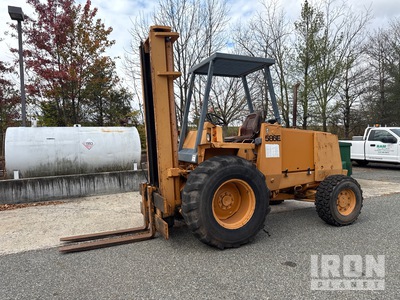필터
결과 108개 중 0-60개 표시
61~108/108
What are rough terrain forklifts?
Rough terrain forklifts are designed to move heavy loads where a conventional warehouse forklift simply can’t go. Instead of smooth concrete floors, these machines work on dirt, gravel, mud, ruts, and uneven ground. You’ll see them on construction sites, in lumberyards, agricultural operations, oil and gas sites, and any outdoor yard where you still need reliable lifting capacity but the surface is far from perfect.
What sets a rough terrain forklift apart is its combination of high ground clearance, larger pneumatic or foam-filled tires, and a more robust frame. Many models feature four-wheel drive, limited-slip differentials, and oscillating axles to keep all four tires in contact with the ground. You’ll typically find two main styles in this category: traditional vertical-mast rough terrain forklifts and telehandler-style machines with an extendable boom. Both are built to handle tough environments, but each suits slightly different jobs and lift requirements.
For buyers, the key question isn’t just “what is a rough terrain forklift?” but “which configuration makes the most
sense for my site, load type, and budget?” The rest of this content is written with that in mind—helping you narrow
down the right machine before you bid or buy.
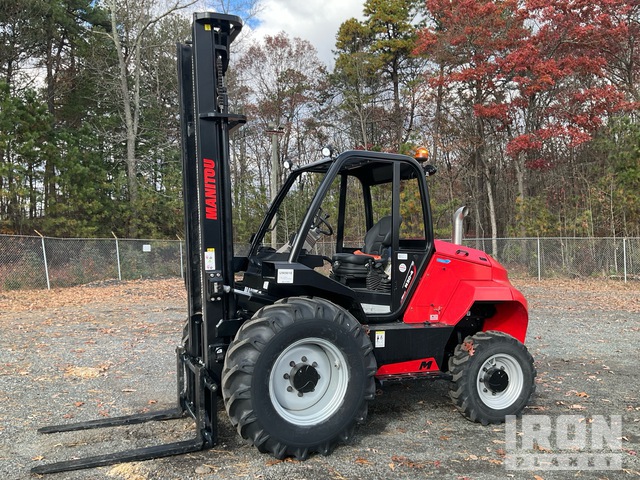
Key features when buying a rough terrain forklift
When you’re comparing rough terrain forklifts side by side, a few core specifications will make the biggest difference to productivity and safety. Looking closely at lift capacity, height, drivetrain, engine, stability, and attachment compatibility will help you choose a machine that fits your work instead of forcing your work to fit the machine.
Lift capacity
Lift capacity is one of the first numbers buyers look at, and for good reason. Common rough terrain forklifts range from around 5,000 lbs up to 12,000 lbs or more, with some specialized units going higher. It’s not enough to match capacity to your heaviest pallet or bundle; you also need to account for uneven surfaces, slopes, and how far the mast or boom is extended. On rough ground, operating near maximum rated capacity leaves little margin, so many operators choose a machine with more headroom than they would in a warehouse setting.
Lift height
Lift height requirements vary by site. Vertical-mast rough terrain forklifts are ideal for loading trucks, stacking materials a few levels high, or working under low-clearance structures. Telehandler-style rough terrain machines, on the other hand, can provide significantly more reach for placing loads on upper levels, scaffolding, or elevated platforms. Knowing the height of your racks, decks, or building floors up front will narrow your search quickly and prevent buying a unit that constantly runs out of reach.
Drivetrain and tires
Drivetrain and tire configuration determine how well the forklift can actually get to the work. Many rough terrain forklifts come with four-wheel drive and oscillating rear axles that keep the tires planted over ruts and washboard. Large pneumatic or foam-filled tires help absorb shock, provide traction, and reduce the risk of flats from debris. If your operation sees deep mud, soft ground, or steep grades, prioritize machines with aggressive tread, solid 4x4 capability, and enough ground clearance to avoid getting hung up on uneven surfaces.
Engine type
Most rough terrain forklifts are powered by diesel engines, chosen for their torque, fuel efficiency, and durability in demanding environments. You may encounter some propane or dual-fuel units, particularly in applications that move between indoor and outdoor spaces, but diesel remains the standard for heavy outdoor work. When evaluating used machines, look for clean starts, minimal smoke, and good throttle response under load. Service records for oil changes, filters, and cooling system maintenance are a strong indicator of how the engine has been cared for.
Stability and frame design
A stable platform is critical when you’re lifting heavy loads on uneven ground. Rough terrain forklifts use wider frames, longer wheelbases, and heavy counterweights to keep the center of gravity in check. Features like side-shift carriages, tilt functions, and good operator visibility all contribute to safer operation. When you inspect a machine, pay attention to mast rails, pins, and bushings, and look for signs of damage or repairs on the frame that could indicate overloading or past accidents.
Attachments and compatibility
Attachments can turn a rough terrain forklift into a multi-purpose material handler. Standard pallet forks are just the starting point; you’ll also see buckets, truss booms, grapples, side-shift or rotating carriages, and specialty forks for lumber, pipe, or block. Before you buy, think about the mix of materials you handle—bulk aggregates, wrapped pallets, long lumber packs, or irregular loads—and confirm that the carriage, hydraulic circuits, and quick-attach system on the machine match the attachments you plan to use.
Buying used vs. new rough terrain forklifts
New rough terrain forklifts offer the latest engines, emissions systems, and operator comforts, but that comes at a premium price. Depreciation in the first few years can be steep, particularly on higher-capacity units or specialty models. For many buyers, especially in construction, rental, and agriculture, the economics of a well-maintained used rough terrain forklift are more attractive than buying new.
Used machines can deliver years of service at a significantly lower acquisition cost, provided you choose carefully. Hours, maintenance history, and application all matter. A forklift that spent its life on paved sites may show very different wear than one that lived on rock piles or demolition projects. When you buy used through a transparent marketplace, with detailed photos and inspection reports, you can compare multiple units side by side and match age, hours, and price to your risk tolerance and workload.
Inspection rough terrain forklift
Start your inspection with the hydraulics. Check cylinders for scoring or pitting, look for leaks at hose fittings and connections, and cycle the mast or boom through its full range to listen for unusual noises. Tilt, side-shift, and auxiliary functions should operate smoothly without jerking or hesitation.
Next, inspect the mast rails, chains, and carriage. Look for uneven wear, bent components, or weld repairs that could affect capacity or stability. Tires tell a story as well: severe chunking, uneven wear, or mismatched pairs can hint at alignment problems or heavy use on harsh surfaces. Underneath, examine the axles, steering components, and frame rails for dents, cracks, or evidence of hard impacts.
Finally, test drive the forklift under load if possible. Check steering response, brake performance, transmission engagement, and parking brake hold. A short functional test will often reveal issues that are not obvious in a static inspection, and it’s one of the best ways to gauge whether a used rough terrain forklift is ready for work or will need immediate investment.
How much do rough terrain forklifts cost?
Pricing for rough terrain forklifts varies widely depending on lift capacity, mast or boom height, brand, age, and total hours. Smaller units in the 5,000–6,000 lb range are generally the most affordable, with used prices commonly starting in the lower bands of the market. Mid-sized machines in the 8,000–10,000 lb range tend to command more, especially if they offer higher lift heights or four-wheel drive as standard.
Larger capacity rough terrain forklifts rated at 12,000 lbs and above, or telehandler-style machines with substantial reach, sit at the higher end of the used price spectrum. Well-known brands such as JCB, Manitou, SkyTrak, Case, Caterpillar, Gehl, and Bobcat often hold their value better due to strong parts support and familiarity among operators and mechanics. Units with lower hours, clean service history, and good rubber will typically justify a higher price, while older machines or those needing tire, hydraulic, or mast work may be available at a discount.
Best applications for rough terrain forklifts
Rough terrain forklifts earn their keep wherever you need to move heavy materials over less-than-ideal ground. On construction and infrastructure projects, they handle pallets of block, pipe, rebar, and bundled materials. In agriculture, they move feed, seed, fertilizer, and bulk totes around yards and fields. Lumberyards and mills use them to stack, load, and unload long packs of lumber or sheet goods on gravel and log decks.
Landscaping suppliers, industrial yards, and outdoor storage operations all rely on rough terrain forklifts to keep material flowing in environments that would stop a standard warehouse truck in its tracks. If your operation spends more time on gravel, dirt, and mud than on polished concrete, a rough terrain forklift is usually the right tool for the job.
Rough terrain forklift vs. telehandler
Buyers often compare rough terrain forklifts with telehandlers because both are designed for outdoor, uneven sites. The key difference is in how they lift: a rough terrain forklift uses a vertical mast to move loads up and down, while a telehandler uses a telescopic boom that can extend outward and upward. If your work involves straightforward lifting, loading trucks, and stacking at moderate heights, a vertical-mast rough terrain forklift is usually more efficient and easier to operate.
Telehandlers shine when you need reach—placing materials on upper floors, reaching over obstacles, or working on sloped ground where you can’t get directly beside the load. They often carry higher purchase prices and require more operator training, but they can replace multiple pieces of equipment on complex sites. In many fleets, the most productive setup is a mix of both: rough terrain forklifts for everyday material handling, paired with telehandlers for high or hard-to-reach placements.
Popular brands and models you will commonly see
In the rough terrain category, certain names appear again and again because they have proven themselves in tough conditions. JCB, Manitou, SkyTrak, Caterpillar, Case, Gehl, and Bobcat all produce capable rough terrain forklifts and telehandlers in a range of capacities. Choosing a well-supported brand can make parts sourcing easier and reduce downtime, especially if your machine is critical to daily site operations.
When you are comparing listings, take note of brand reputation alongside the usual specs like capacity, height, and hours. A well-known manufacturer with good dealer coverage in your region can be just as important as the numbers on the data plate when it comes to long-term ownership and serviceability.

